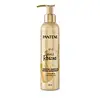What's inside
What's inside
 Key Ingredients
Key Ingredients

No key ingredients
 Benefits
Benefits

 Concerns
Concerns

 Ingredients Side-by-side
Ingredients Side-by-side

Water
Skin ConditioningPropylene Glycol
HumectantCetearyl Alcohol
EmollientCyclopentasiloxane
EmollientBehentrimonium Chloride
PreservativeQuaternium-80
Phenoxyethanol
PreservativeParfum
MaskingMethylparaben
PreservativePanthenol
Skin ConditioningPropylparaben
PreservativeEthylparaben
PreservativeAloe Barbadensis Leaf Juice
Skin ConditioningButylene Glycol
HumectantSodium Hydroxide
BufferingHydrolyzed Keratin
HumectantKeratin Amino Acids
Skin ConditioningHelianthus Annuus Seed Extract
Skin ConditioningSilk Amino Acids
HumectantCamellia Sinensis Leaf Extract
AntimicrobialBenzyl Benzoate
AntimicrobialBenzyl Salicylate
PerfumingHydroxycitronellal
PerfumingLinalool
PerfumingWater, Propylene Glycol, Cetearyl Alcohol, Cyclopentasiloxane, Behentrimonium Chloride, Quaternium-80, Phenoxyethanol, Parfum, Methylparaben, Panthenol, Propylparaben, Ethylparaben, Aloe Barbadensis Leaf Juice, Butylene Glycol, Sodium Hydroxide, Hydrolyzed Keratin, Keratin Amino Acids, Helianthus Annuus Seed Extract, Silk Amino Acids, Camellia Sinensis Leaf Extract, Benzyl Benzoate, Benzyl Salicylate, Hydroxycitronellal, Linalool
Water
Skin ConditioningDimethicone
EmollientCetyl Alcohol
EmollientStearyl Alcohol
EmollientHydrolyzed Keratin
HumectantSimmondsia Chinensis Seed Oil
EmollientArgania Spinosa Kernel Oil
EmollientPanthenol
Skin ConditioningPanthenyl Ethyl Ether
Histidine
HumectantStearamidopropyl Dimethylamine
EmulsifyingSorbitan Caprylate
EmulsifyingHydroxyethylcellulose
Emulsion StabilisingQuaternium-18
PEG-2m
Emulsion StabilisingCetearyl Alcohol
EmollientOleyl Alcohol
EmollientGlyceryl Stearate
EmollientPolysorbate 60
EmulsifyingParfum
MaskingCitric Acid
BufferingLysine Hcl
Skin ConditioningBenzyl Alcohol
PerfumingEDTA
Water, Dimethicone, Cetyl Alcohol, Stearyl Alcohol, Hydrolyzed Keratin, Simmondsia Chinensis Seed Oil, Argania Spinosa Kernel Oil, Panthenol, Panthenyl Ethyl Ether, Histidine, Stearamidopropyl Dimethylamine, Sorbitan Caprylate, Hydroxyethylcellulose, Quaternium-18, PEG-2m, Cetearyl Alcohol, Oleyl Alcohol, Glyceryl Stearate, Polysorbate 60, Parfum, Citric Acid, Lysine Hcl, Benzyl Alcohol, EDTA
Ingredients Explained
These ingredients are found in both products.
Ingredients higher up in an ingredient list are typically present in a larger amount.
Cetearyl alcohol is a mixture of two fatty alcohols: cetyl alcohol and stearyl alcohol. It is mainly used as an emulsifier. Emulsifiers help prevent the separation of oils and products. Due to its composition, it can also be used to thicken a product or help create foam.
Cetearyl alcohol is an emollient. Emollients help soothe and hydrate the skin by trapping moisture.
Studies show Cetearyl alcohol is non-toxic and non-irritating. The FDA allows products labeled "alcohol-free" to have fatty alcohols.
This ingredient is usually derived from plant oils such as palm, vegetable, or coconut oils. There is debate on whether this ingredient will cause acne.
Due to the fatty acid base, this ingredient may not be Malassezia folliculitis safe.
Learn more about Cetearyl AlcoholHydrolyzed Keratin is derived from keratin. Keratin is a large protein that is naturally found in our hair and skin.
Studies show keratin is able to seal broken hair cuticles, helping to prevent split ends and breakage.
As a humectant, hydrolyzed keratin helps draw moisture from the air to your hair and skin. This helps keep your skin and hair hydrated.
Learn more about Hydrolyzed KeratinPanthenol is a common ingredient that helps hydrate and soothe the skin. It is found naturally in our skin and hair.
There are two forms of panthenol: D and L.
D-panthenol is also known as dexpanthenol. Most cosmetics use dexpanthenol or a mixture of D and L-panthenol.
Panthenol is famous due to its ability to go deeper into the skin's layers. Using this ingredient has numerous pros (and no cons):
Like hyaluronic acid, panthenol is a humectant. Humectants are able to bind and hold large amounts of water to keep skin hydrated.
This ingredient works well for wound healing. It works by increasing tissue in the wound and helps close open wounds.
Once oxidized, panthenol converts to pantothenic acid. Panthothenic acid is found in all living cells.
This ingredient is also referred to as pro-vitamin B5.
Learn more about PanthenolParfum is a catch-all term for an ingredient or more that is used to give a scent to products.
Also called "fragrance", this ingredient can be a blend of hundreds of chemicals or plant oils. This means every product with "fragrance" or "parfum" in the ingredients list is a different mixture.
For instance, Habanolide is a proprietary trade name for a specific aroma chemical. When used as a fragrance ingredient in cosmetics, most aroma chemicals fall under the broad labeling category of “FRAGRANCE” or “PARFUM” according to EU and US regulations.
The term 'parfum' or 'fragrance' is not regulated in many countries. In many cases, it is up to the brand to define this term.
For instance, many brands choose to label themselves as "fragrance-free" because they are not using synthetic fragrances. However, their products may still contain ingredients such as essential oils that are considered a fragrance by INCI standards.
One example is Calendula flower extract. Calendula is an essential oil that still imparts a scent or 'fragrance'.
Depending on the blend, the ingredients in the mixture can cause allergies and sensitivities on the skin. Some ingredients that are known EU allergens include linalool and citronellol.
Parfum can also be used to mask or cover an unpleasant scent.
The bottom line is: not all fragrances/parfum/ingredients are created equally. If you are worried about fragrances, we recommend taking a closer look at an ingredient. And of course, we always recommend speaking with a professional.
Learn more about ParfumWater. It's the most common cosmetic ingredient of all. You'll usually see it at the top of ingredient lists, meaning that it makes up the largest part of the product.
So why is it so popular? Water most often acts as a solvent - this means that it helps dissolve other ingredients into the formulation.
You'll also recognize water as that liquid we all need to stay alive. If you see this, drink a glass of water. Stay hydrated!
Learn more about Water